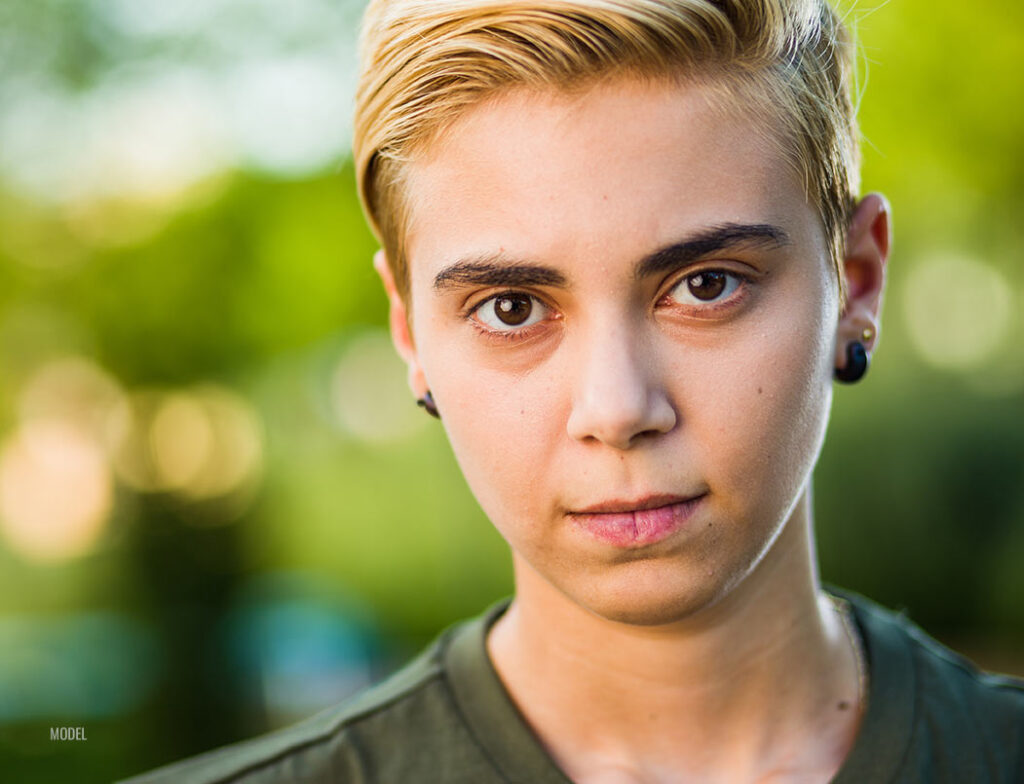Home|Blog | Understanding FTM/FTN Top Surgery Techniques
Understanding FTM/FTN Top Surgery Techniques

5 Min Read:
For individuals assigned female at birth who identify as male, gender nonbinary or genderqueer, undergoing top surgery is a transformational step in aligning their physical appearance with their gender identity. Top surgery, the gender-affirming procedure addressing chest dysphoria, involves removing and/or reshaping breast tissue to create the specific desired chest contour.
This article explores the surgical techniques used in FTM (female to male) and FTN (female to gender nonbinary/genderqueer) top surgery, including key considerations and potential outcomes.
Why Undergo FTM or FTN Top Surgery?
On the journey to one’s true self, FTM and FTN top surgery can be life-changing procedures that help individuals align their physical appearance with their gender identity and improve their overall well-being. By working closely with a board-certified plastic surgeon who specializes in transgender procedures, patients can explore their options, understand the surgical techniques available, and develop a personalized treatment plan to achieve their desired chest contour.
For those who feel their chest appearance does not match their gender identity, having top surgery can make them feel more comfortable with their bodies. FTM and FTN top surgery are transformative procedures that are designed to help transmen, gender nonbinary and genderqueer individuals achieve the chest contours they desire.
Patients should/must undergo counseling and psychological evaluation before surgery so as to determine if they are psychologically, intellectually and physically ready to proceed and if their desire is appropriate. This is extremely important in helping to minimize the risk of detransitioning later on.
Having a healthy support system in place is also very important.
Before Top Surgery
Before undergoing FTM or FTN top surgery, individuals will typically undergo a comprehensive evaluation with a board-certified plastic surgeon who specializes in transgender healthcare. Among some of the areas explored and discussed during this consultation are:
- Explicit history of one’s gender identity journey including psychological facets and present functioning
- Determination of patient’s goals, expectations and motivations
- Therapy treatments, assessments, results and if a supportive letter has been completed
- Assessment of patient’s physical and psychological health
- Thorough physical examination
- Recommendations for surgical treatment based on options appropriate for them
- Review of expectations of outcome including risks and potential complications
Before deciding to undergo FTM or FTN top surgery, patients must clearly understand the surgery’s potential risks, benefits, and limitations as well as have appropriate expectations for both short and long term.
Surgical Techniques for FTM and FTN Top Surgery
Top surgery procedures are highly customizable with each method tailored to the patient’s unique anatomy, aesthetic goals and specific gender identity. This relates to the breasts, nipples-areola complexes and the chest wall.
Keyhole Mastectomy
A keyhole mastectomy involves removing breast tissue through an incision in the lower half of the areola. This technique is a good option for small breasts with good skin tone and areolas of the proper size.
Concentric Circle (Circumareolar or Periareolar) Mastectomy
This technique involves incisions around the perimeter of the areolas, which facilitates the reduction of areola size and effective skin tightening along with the removal of the breast tissue. This approach is ideal for individuals with smaller breasts–generally around a “B” cup.
Double Incision Mastectomy with Free Nipple Graft
With this technique, incisions are made transversely on each side of the chest, allowing for the removal of the breast tissue and excess skin along with chest wall contouring. The nipple-areola complexes are permanently removed and then placed back on the chest wall in the desired location as full-thickness skin grafts.
Double Incision Mastectomy Without Free Nipple Grafts
This technique replicates the double incision mastectomy as described above, except that the nipple-areola complexes are permanently removed and not placed back on the chest. This approach is a frequent preference for gender non-binary and genderqueer patients. Some FTM individuals also request this approach.
Customized Chest Contouring
Especially for some genderqueer individuals, other surgical techniques may be considered depending on goals and preferences. For example, those individuals who are seeking an androgynous look may benefit from a gender-affirming breast reduction that leaves some breast tissue, typically around an “A” or “B” cup. The focus is creating a chest appearance that aligns with the patient’s desired gender expression, which may involve a combination of liposuction, tissue excision, and skin tightening to achieve the desired chest contour.
Postoperative Care and Recovery
Following FTM or FTN top surgery, patients will require time off for recovery to allow for proper healing. Their recovery may involve wearing compression garments, avoiding strenuous activities and showing up for scheduled postoperative appointments with their surgeon.
It is critically important to follow instructions and guidelines provided by one’s plastic surgeon.
Outcomes and Considerations
With proper preoperative preparation, skilled surgical techniques, attentive postoperative care and strict compliance with instructions and guidelines, FTM and FTN top surgery can empower individuals to embrace their authentic selves with joy and relief.
While surgical techniques have advanced significantly in recent years, patients need to have realistic expectations about the potential outcomes of their gender-affirming top surgery—both physically and psychologically.
Top surgery is undeniably life-changing in many positive ways.
Our Phoenix and Scottsdale Transgender & Gender Nonbinary Top Surgery Specialist
Dr. Steven Turkeltaub is a renowned, board-certified plastic surgeon in Scottsdale, Arizona, specializing in female to male (FTM) and female to gender nonbinary top surgery.
Learn more by calling 480.451.3000 and scheduling your thorough consultation with Dr. Turkeltaub.
